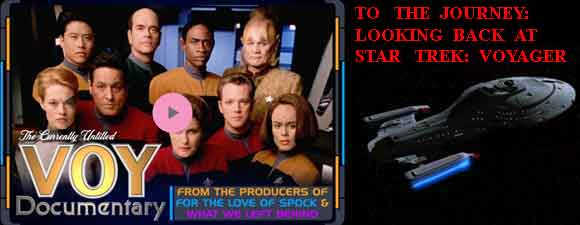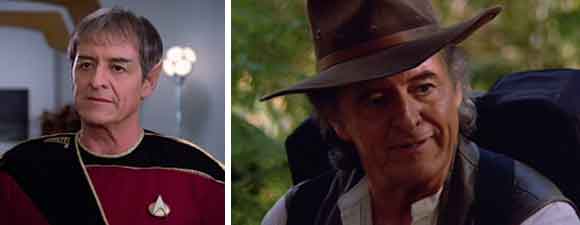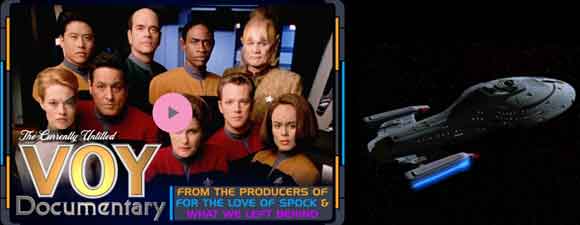Retro Review: Faces
6 min readThe Vidiians divide Torres into separate Klingon and Human individuals, hoping that the Klingon’s DNA will provide a cure for the phage.
Plot Summary: A group of Vidiians abducts Torres along with Paris and Durst while the crewmembers study magnesite formations on a mineral-rich planet. Torres wakes in a room to discover that all the Human elements have been purged from her – she is now wholly Klingon, and seemingly able to fight off the phage that has decimated the Vidiian species. The two men are sent to labor in the magnesite mines and sleep in a group prison. There, Paris encounters a wholly Human Torres created when the Klingon Torres was separated from her. Though relieved to be free of her violent, uncontrollable Klingon side, the Human Torres feels weak and disoriented, while the Klingon Torres, though proud of her strength, is enraged to be held captive. The Klingon flirts with Sulan, the doctor experimenting upon her, hoping to gain a measure of freedom, but he wishes to win her affections and has Durst killed so that he can graft the officer’s face onto his own. Horrified, the Klingon Torres attacks Sulan and flees, finding the Human Torres as the latter tries to hack into the Vidiian security grid to contact Voyager. The Human and Klingon argue bitterly about their resentment of one another, then realize that they will only escape if they work together. Once Voyager’s officers discover the Vidiians on the planet, Chakotay disguises himself as a Vidiian in an attempt to find the missing crewmembers. He and Paris catch up with the two B’Elannas just as the latter brings down the Vidiian force field. Sulan tries to kill the Human in order to trap the others, yet the Klingon places herself in the line of fire and dies in Voyager’s transporter room. Just as she is coming to terms with the schism, the Human Torres learns from the Doctor that her Klingon DNA must be reinfused or she will die from protein imbalances. Tearfully, she admits to Chakotay that she feels more at peace being fully Human and she knows she’ll spend the rest of her life fighting with the stronger, braver side of herself.
Analysis: “Faces” is most effective when regarded as a character study of B’Elanna Torres and a demonstration of Roxann Dawson’s acting range, since the plot doesn’t hold up well under scrutiny, and the science at the core is fairly preposterous. It’s engrossing to watch the two halves of Torres confront one another and fun to explore these early moments of emotional bonding between Torres and Paris now that we know they’ll end up married to each other. Yet it’s hard to ignore the aspects that just don’t make sense, starting with a species whom we’re supposed to believe can reconstitute one biracial alien into two fully conscious, sentient people through the use of “a kind of enhanced mitosis” yet can’t clone body parts or individuals to replace the ones destroyed by the phage. The Evil Twin story also isn’t an original idea. Though Star Trek experimented before Voyager with splitting characters in half – the good and evil Kirks in “The Enemy Within,” the two Rikers in “Second Chances,” not to mention various Mirror Universe doubles – the obvious antecedent for “Faces” is Claire Gabriel’s story “Ni Var” from Bantam’s Star Trek: The New Voyages anthology, in which Spock’s Human and Vulcan halves are divided for medical research and the character must come to terms with the painful need to reintegrate them. (I refrained from mentioning this when I first reviewed the episode because Gabriel is a personal friend and I wasn’t sure how she’d feel about me publicly accusing the writers of stealing her idea about a dual-species character being being split by alien technology – I also wasn’t sure whether Gabriel had ceded her intellectual property rights over the science fiction concept to the franchise when she agreed to have her story published, the way Strange New Worlds contest winners did later – but at this point, dozens of reviewers have remarked upon the apparent uncredited swipe.)
I like seeing the Vidiians again, as well as another Talaxian, the fellow prisoner who tries to help Voyager’s crewmembers survive as laborers before being chopped up for parts. It’s nice when Voyager can show recurring species, knowing they’re unlikely to be overused like the Ferengi because the ship will be moving through the quadrant. But though we see an interesting contrast between ebullient Neelix and the weary Talaxian prisoner, the Vidiians end up looking more like stock villains than a developed alien race. The desperate characters of “Phage” have been replaced by a twist on old, ugly stereotypes about lepers – repulsive to look at and morally corrupt, yet otherwise able to go about their business as if they weren’t suffering from a devastating disease. These aren’t wracked and woeful creatures dying by the thousands, but an organized society that keeps slaves in labor camps to do their dirty work, only to kill and harvest the body parts of those slaves as they need them. In creating a medical conundrum for Torres, the writers sacrifice the complexity of this species that was so much more interesting and sympathetic when we first encountered them. There’s also the not-insignificant problem of Janeway’s threat to meet the Vidiians with the deadliest of force if they come after anyone on her crew again. Now that we all know that they’ve determined Klingon DNA can resist the phage, there’s no reason to believe they won’t come after Voyager again and in far greater numbers, so instead of racing away at the end, there could be an interesting debate about whether to get rid of Sulan and anyone else who knows about Torres’ value to them, not to mention some effort to free people like the friendly Talaxian trapped in the Vidiian prison. In the end, Janeway and Chakotay both leave Torres alone to face fears that she’ll be targeted again, as well as the complexity of having to reintegrate her Klingon side, without so much as a pep talk.
In general it’s puzzling why the Klingon Torres is so proud of a heritage that every part of her resented while growing up. Her Klingon half doesn’t have repressed nostalgic memories of the mother to whom she no longer speaks, so why would she suddenly be using Klingon phrases and curses? Discovering that she now has strength doesn’t mean that she must accept the bullying, patriarchal ideology that most Klingons glorify, let alone the need for an honorable death in battle. And the Klingon must enjoy engineering, even if it’s her Human half that gives her the patience to solve problems, because she doesn’t throw tantrums about working on machinery. I like Torres better when she’s more like Kira, pulled apart by opposing ideologies, than when she believes biology is destiny and her strength comes from being Klingon while her intellect comes from being Human. It’s a disservice to both species, as we already know from watching fully Klingon Worf and honorary Klingon Dax. The fully human Paris points out that he and Torres have similar abandonment issues despite having been raised in very different environments, and it’s nice to be reminded of all the things they have in common from so early in their friendship. In fact, Paris is an ideal commander here, insisting as the senior officer on being taken to probable death in place of Durst – Voyager’s first, rare red-shirt – trying to help a weaker crewmember when sent to the labor camps, offering comfort and planning rescues for junior officers. I understand that Janeway can’t always promise the sort of consolation she gave Kim after his experience of being dead and resurrected, and it would be redundant to show it, but it’s Paris, not Janeway or Chakotay, who looks like the most empathetic leader here as a result. Maybe with her Klingon half reintegrated, Torres privately knocks their heads together about that, though it’s also impressive to see the strength of the Human side alone at the end…to know that even when she feels weak, she doesn’t surrender to fear.







One of the best Voyager episodes, really, buoyed by a ghoulish sense of humour.
Another somewhat disturbing episode with the Vidiians. Memorable for sure, if only for Durst’s grim fate. But this episode does indeed have too many issues. My rating: 6/10.
I always thought this premise would have worked well with Spock.
my favourite ep from season one but the fact that its events where not referred to again in the series or used to help develop torres’ character arc showed one of the problems that would plague Voy throughout its run.
Splitting people into halves is as old as Jekyll and Hyde. With all due respect to your friend, separating Spock into human and Vulcan halves is so obvious an idea that it was bound to occur to lots of people independently, plus one can only copyright arrangements of words, not ideas.
I thought this was a fantastically interesting episode for B’Elanna’s character, and I was willing to overlook the lesser parts of the episode because of it.
This would have been fantastic with Spock, but they probably didn’t want to do something so similar to “The Enemy Within.” It’s a pity, because Leonard Nimoy would have been astonishing in those dual roles!
nice seo services